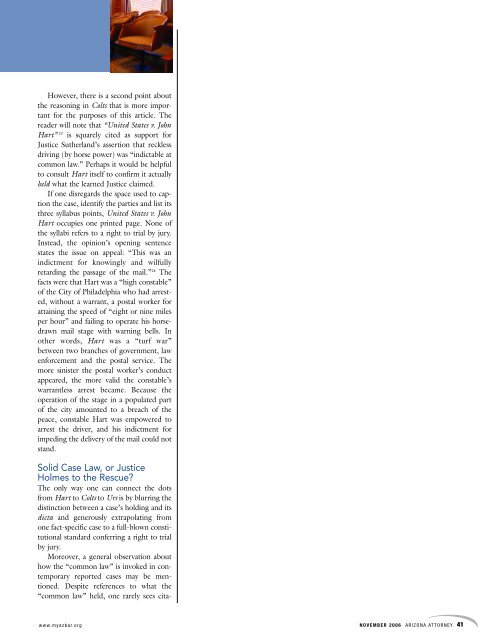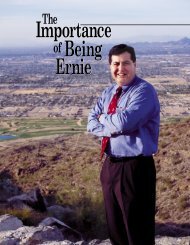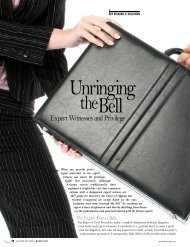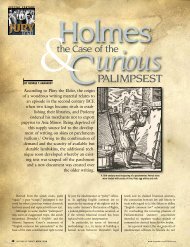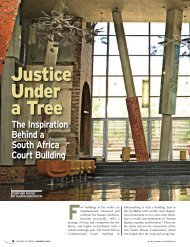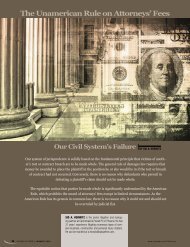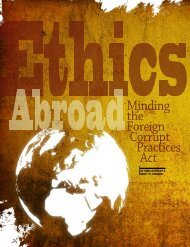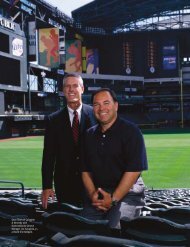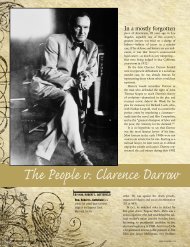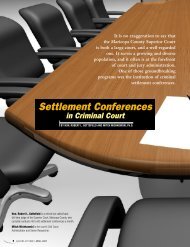However, there is a second point aboutthe reasoning in Colts that is more importantfor the purposes of this article. Thereader will note that “United States v. JohnHart” 23 is squarely cited as support forJustice Sutherland’s assertion that recklessdriving (by horse power) was “indictable atcommon law.” Perhaps it would be helpfulto consult Hart itself to confirm it actuallyheld what the learned Justice claimed.If one disregards the space used to captionthe case, identify the parties and list itsthree syllabus points, United States v. JohnHart occupies one printed page. None ofthe syllabi refers to a right to trial by jury.Instead, the opinion’s opening sentencestates the issue on appeal: “This was anindictment for knowingly and wilfullyretarding the passage of the mail.” 24 Thefacts were that Hart was a “high constable”of the City of Philadelphia who had arrested,without a warrant, a postal worker forattaining the speed of “eight or nine milesper hour” and failing to operate his horsedrawnmail stage with warning bells. Inother words, Hart was a “turf war”between two branches of government, lawenforcement and the postal service. Themore sinister the postal worker’s conductappeared, the more valid the constable’swarrantless arrest became. Because theoperation of the stage in a populated partof the city amounted to a breach of thepeace, constable Hart was empowered toarrest the driver, and his indictment forimpeding the delivery of the mail could notstand.Solid Case Law, or JusticeHolmes to the Rescue?The only way one can connect the dotsfrom Hart to Colts to Urs is by blurring thedistinction between a case’s holding and itsdicta and generously extrapolating fromone fact-specific case to a full-blown constitutionalstandard conferring a right to trialby jury.Moreover, a general observation abouthow the “common law” is invoked in contemporaryreported cases may be mentioned.Despite references to what the“common law” held, one rarely sees citawww.myazbar.orgNOVEMBER 2006 ARIZONA ATTORNEY 41
TRIALJURYBYtion to actual English common law caseswhose holdings involved a determination ofthe right to trial by jury. The uncertaintysurrounding this interplay of myriad offenses,statutes and centuries of evolving caselaw jurisprudence cuts in both directions—first by failing to identify a true source ofdecisional law that articulates an ascertainablejury trial right 25 and then by re-validatingthe “bright-line” standard enunciated inBaldwin and approved in Derendal. As boththose cases acknowledged, the most objectivebasis by which to measure the seriousnessof criminal conduct is to ascertain thepotential maximum penalty of imprisonmentthat might be assessed.Short of that, searching for “commonlaw” antecedents whose elements are analogousto modern-day crimes opens aninquiry that risks incomplete historicalrecords, assumptions or speculation as tohow the law was actually interpreted in thepast. It also allows potentially artificial comparisonsseparated by centuries of time andexperience. As Justice Felix Frankfurterobserved, “[W]hile the Constitution waswritten in 1787, it was not written for1787.” 26In a different setting, Justice Holmes’skepticism as to a knowable and discretebody of common law is also noteworthy. InBlack and White Taxicab v. Brown andYellow Taxicab, 27 Black and White brought adiversity suit in federal court to enjoinBrown and Yellow from interfering with anexclusive railroad passenger cab service contract.Brown and Yellow answered that theKentucky appellate courts had ruled suchexclusive contracts were invalid restraints oftrade.Nevertheless, the U.S. Supreme Courtruled against Brown and Yellow, holdingthat it was not bound by the Kentucky statecourt’s interpretation of the common lawand that it could determine and apply a generalAmerican common law. Justice Holmesdissented with observations that would bevindicated a few years later in Erie RailroadCo. v. Tompkins, 28 which held that there wasno general federal common law in diversitycases.Books written about any branch ofthe common law treat it as a unit,cite cases from this Court, from theCircuit Courts of Appeal, from theState Courts, from England and theColonies of England indiscriminately,and criticise them as right or wrongaccording to the writer’s notions of asingle theory. It is very hard to resistthe impression that there is oneaugust corpus. … If there were sucha transcendental body of law … theCourts of the United States might beright in using their independentjudgment as to what it was. Butthere is no such body of law. The fallacyand illusion that I think existconsist in supposing that there is thisoutside thing to be found. 29ConclusionWith the stroke of a pen, by applying thereasoning used in Colts, the Court inDerendal could have easily reached anopposite result and held that drag racingwas a common law analog worthy of trialby jury. After all, drag racing is inherentlydangerous, its motive power is a horsemade of steel, and as such, it would beindictable as a common law breach of thepeace. The rub here is that, ultimately,whichever way Derendal went, it is notclear that common law sources would havecompelled either holding one way or theother.Certainty in the law should be one of itsmost important goals. With certainty,rights, duties and other jural correlativesbecome verifiable and predictable. Withcertainty, the law can attain objective standardsof fairness and justice. Lastly, on aless important pragmatic level, certaintycan reduce the flow of litigation and thesocial cost of expending judicial resources,time and effort to declare what the law is.Derendal represents an important stepin understanding the meaning of a constitutionalright. But in that case the Courtalso announced that some aspects ofEnglish common law still cast a shadowover the Sixth Amendment on the basis ofsimilar elements. Given that imperative, thequestion remains whether we will continueto search for a common law tradition thatis intractably elusive.AZATendnotes1. 104 P.3d 147 (Ariz. 2005).2. 410 P.2d 479 (Ariz. 1966). The threeprongs that conferred a right to trial by jurywere “serious” offenses due to the length ofpotential imprisonment, common lawoffenses, and offenses involving moral turpitude.3. Derendal, 104 P.3d at 150.4. Baldwin v. New York, 399 U.S. 66 (1970)(New York statute that authorized a maximumpenalty of one-year imprisonment for“jostling” was jury eligible).5. Blanton v. City of North Las Vegas, 498 U.S.538 (1989) (Nevada DUI statute, whichauthorized up to six months in jail, classesand distinctive garb while performing communityservice was not a “serious” offenserequiring a jury trial).6. ARIZ. CONST. art. 2, § 23.7. In Stoudamire v. State of Arizona (2006 WL2129993 Ariz. App. Div. 2), defendant wascharged with “felony turn-down” misdemeanormarijuana and drug paraphernaliapossession offenses. The court of appealsrejected his alternative arguments that hiscrimes were analogous to a common lawpossession of opium offense or that theoverall “seriousness” of the offense overcamethe Derendal presumption that sixmonthor less offenses are “petty” innature. See also Manic v. Dawes (2006 WL667959 Ariz. App. Div. 2); State ex rel.Wangberg v. Smith, 118 P.3d 49 (Ariz. Ct.App. 2005); Phoenix City Prosecutors Officev. Klausner, 118 P.3d 1141 (Ariz. Ct. App.2005); Ottaway v. Smith, 113 P.3d 1247(Ariz. Ct. App. 2005).8. See O’Neill v. Mangum, 445 P.2d 843 (Ariz.1968).9. City Court v. Lee, 494 P.2d 54 (Ariz. Ct.App. 1972).10. State v. Miller, 836 P.2d 1004 (Ariz. Ct.App. 1974).11. State v. Superior Court, 589 P.2d 48 (Ariz.1978).12. State v. Cousins, 397 P.2d 217 (Ariz. 1964).13. Rothweiler, 410 P.2d 479. A.R.S. § 28-1381(F) provides a statutory right to trialby jury for DUI misdemeanors. A.R.S. § 5-397(C) provides a right to trial by jury foroperating a watercraft under the influence.Curiously, there is no statutory right to trialby jury for operating an aircraft while intoxicated.See A.R.S. § 28-8284.14. See generally A.R.S. § 13-1602.42 ARIZONA ATTORNEY NOVEMBER 2006www.myazbar.org


